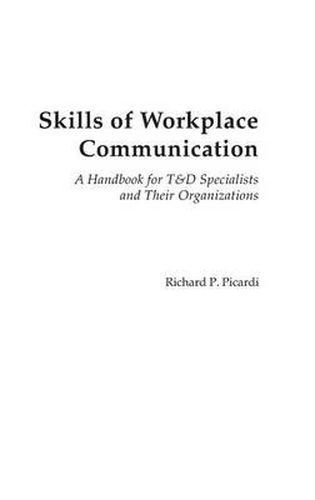Readings Newsletter
Become a Readings Member to make your shopping experience even easier.
Sign in or sign up for free!
You’re not far away from qualifying for FREE standard shipping within Australia
You’ve qualified for FREE standard shipping within Australia
The cart is loading…






A comprehensive, practical handbook of ways to communicate your ideas - and yourself–in writing effectively and a guide for T&D specialists in organizations of any size, public or private, who must teach these skills to others. Ability and skill are important–but not everything. Equally important is how you communicate yourself–your competencies and achievements–to others. Teacher and consultant Richard Picardi takes a long, thoughtful look at the things we all need to know to make our ideas heard and understood in today’s noisy, hotly competitive organizations. He covers not just the skills of putting your ideas, recommendations and analyses in writing, but also the other way in which effective communication is also accomplished: nonverbally. He shows you the internal and external roadblocks to effective communications and how to break through them. In Part I, Picardi analyzes the nature of verbal and nonverbal communication. He shows how to recognize and remove internal and external barriers to effective communication and create messages that get the results you want. He then focuses on the specific goals of business communication, showing how the concept of change interacts with all forms of communication–in fact, how change is implicit in them. Picardi lays out the elements of organization that are essential in creating reader-based messages, then how to compose the clear, forceful sentences and paragraphs to express them. Later, in Part III, he presents his system of text boxes, showing how to write typical business memos and letters, using direct and indirect patterns of writing to demonstrate different types of messages you want to communicate, and ends with a systematic method to revise and improve upon first drafts. He goes on to apply the principles of reader-based communication, effective organization, and clear expression to proposal and report writing. He shows how proposals differ from reports and how to write both effectively. For training and development specialists, the book provides the material you need to teach these skills to others.
$9.00 standard shipping within Australia
FREE standard shipping within Australia for orders over $100.00
Express & International shipping calculated at checkout
A comprehensive, practical handbook of ways to communicate your ideas - and yourself–in writing effectively and a guide for T&D specialists in organizations of any size, public or private, who must teach these skills to others. Ability and skill are important–but not everything. Equally important is how you communicate yourself–your competencies and achievements–to others. Teacher and consultant Richard Picardi takes a long, thoughtful look at the things we all need to know to make our ideas heard and understood in today’s noisy, hotly competitive organizations. He covers not just the skills of putting your ideas, recommendations and analyses in writing, but also the other way in which effective communication is also accomplished: nonverbally. He shows you the internal and external roadblocks to effective communications and how to break through them. In Part I, Picardi analyzes the nature of verbal and nonverbal communication. He shows how to recognize and remove internal and external barriers to effective communication and create messages that get the results you want. He then focuses on the specific goals of business communication, showing how the concept of change interacts with all forms of communication–in fact, how change is implicit in them. Picardi lays out the elements of organization that are essential in creating reader-based messages, then how to compose the clear, forceful sentences and paragraphs to express them. Later, in Part III, he presents his system of text boxes, showing how to write typical business memos and letters, using direct and indirect patterns of writing to demonstrate different types of messages you want to communicate, and ends with a systematic method to revise and improve upon first drafts. He goes on to apply the principles of reader-based communication, effective organization, and clear expression to proposal and report writing. He shows how proposals differ from reports and how to write both effectively. For training and development specialists, the book provides the material you need to teach these skills to others.